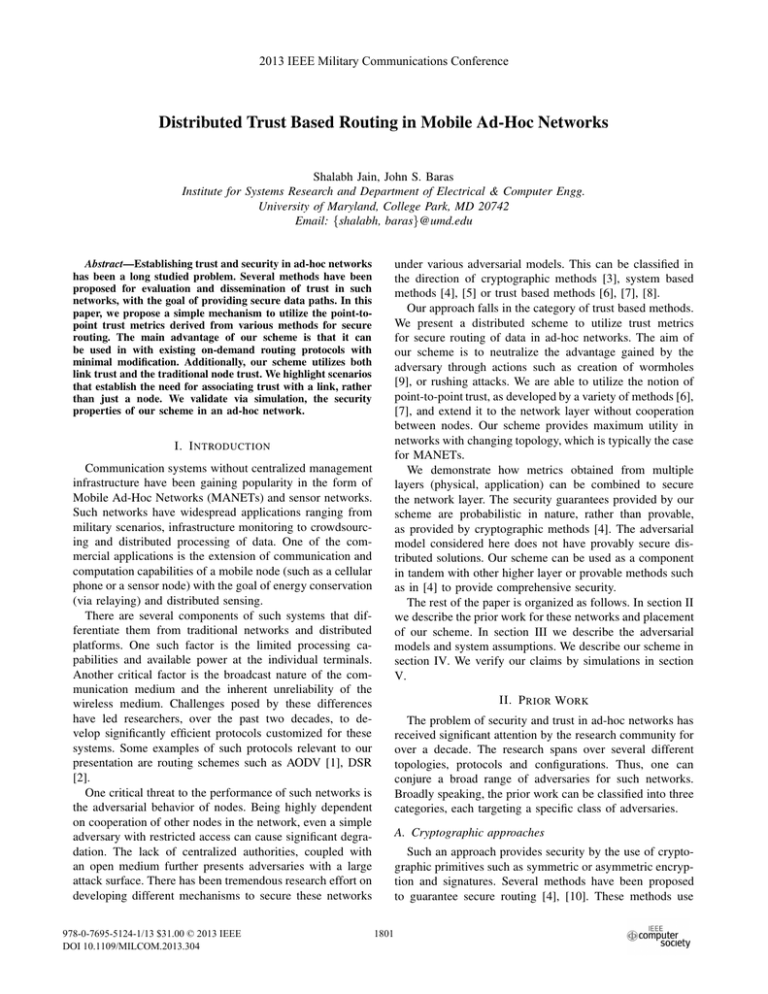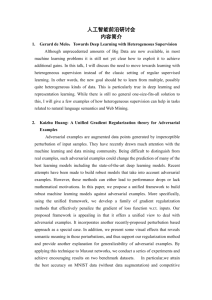Distributed Trust Based Routing in Mobile Ad-Hoc Networks
advertisement

2013 IEEE Military Communications Conference
Distributed Trust Based Routing in Mobile Ad-Hoc Networks
Shalabh Jain, John S. Baras
Institute for Systems Research and Department of Electrical & Computer Engg.
University of Maryland, College Park, MD 20742
Email: {shalabh, baras}@umd.edu
Abstract—Establishing trust and security in ad-hoc networks
has been a long studied problem. Several methods have been
proposed for evaluation and dissemination of trust in such
networks, with the goal of providing secure data paths. In this
paper, we propose a simple mechanism to utilize the point-topoint trust metrics derived from various methods for secure
routing. The main advantage of our scheme is that it can
be used in with existing on-demand routing protocols with
minimal modification. Additionally, our scheme utilizes both
link trust and the traditional node trust. We highlight scenarios
that establish the need for associating trust with a link, rather
than just a node. We validate via simulation, the security
properties of our scheme in an ad-hoc network.
under various adversarial models. This can be classified in
the direction of cryptographic methods [3], system based
methods [4], [5] or trust based methods [6], [7], [8].
Our approach falls in the category of trust based methods.
We present a distributed scheme to utilize trust metrics
for secure routing of data in ad-hoc networks. The aim of
our scheme is to neutralize the advantage gained by the
adversary through actions such as creation of wormholes
[9], or rushing attacks. We are able to utilize the notion of
point-to-point trust, as developed by a variety of methods [6],
[7], and extend it to the network layer without cooperation
between nodes. Our scheme provides maximum utility in
networks with changing topology, which is typically the case
for MANETs.
We demonstrate how metrics obtained from multiple
layers (physical, application) can be combined to secure
the network layer. The security guarantees provided by our
scheme are probabilistic in nature, rather than provable,
as provided by cryptographic methods [4]. The adversarial
model considered here does not have provably secure distributed solutions. Our scheme can be used as a component
in tandem with other higher layer or provable methods such
as in [4] to provide comprehensive security.
The rest of the paper is organized as follows. In section II
we describe the prior work for these networks and placement
of our scheme. In section III we describe the adversarial
models and system assumptions. We describe our scheme in
section IV. We verify our claims by simulations in section
V.
I. I NTRODUCTION
Communication systems without centralized management
infrastructure have been gaining popularity in the form of
Mobile Ad-Hoc Networks (MANETs) and sensor networks.
Such networks have widespread applications ranging from
military scenarios, infrastructure monitoring to crowdsourcing and distributed processing of data. One of the commercial applications is the extension of communication and
computation capabilities of a mobile node (such as a cellular
phone or a sensor node) with the goal of energy conservation
(via relaying) and distributed sensing.
There are several components of such systems that differentiate them from traditional networks and distributed
platforms. One such factor is the limited processing capabilities and available power at the individual terminals.
Another critical factor is the broadcast nature of the communication medium and the inherent unreliability of the
wireless medium. Challenges posed by these differences
have led researchers, over the past two decades, to develop significantly efficient protocols customized for these
systems. Some examples of such protocols relevant to our
presentation are routing schemes such as AODV [1], DSR
[2].
One critical threat to the performance of such networks is
the adversarial behavior of nodes. Being highly dependent
on cooperation of other nodes in the network, even a simple
adversary with restricted access can cause significant degradation. The lack of centralized authorities, coupled with
an open medium further presents adversaries with a large
attack surface. There has been tremendous research effort on
developing different mechanisms to secure these networks
978-0-7695-5124-1/13 $31.00 © 2013 IEEE
DOI 10.1109/MILCOM.2013.304
II. P RIOR W ORK
The problem of security and trust in ad-hoc networks has
received significant attention by the research community for
over a decade. The research spans over several different
topologies, protocols and configurations. Thus, one can
conjure a broad range of adversaries for such networks.
Broadly speaking, the prior work can be classified into three
categories, each targeting a specific class of adversaries.
A. Cryptographic approaches
Such an approach provides security by the use of cryptographic primitives such as symmetric or asymmetric encryption and signatures. Several methods have been proposed
to guarantee secure routing [4], [10]. These methods use
1801
strong authentication for identification of nodes and encryption or signatures to guarantee non-malleability of the
routing packets. Though these protocols provide provable
guarantees, they fail to prevent several types of attacks
(e.g.: wormholes, greyholes, rushing, sybil). Additionally,
cryptographic operations incur significant computational and
energy overhead, undesirable for small devices.
B. Trust based methods
Such methods develop the notion of trust in a network,
characterized as the degree of correctness of the behavior
of a network participant from the view of another. This
typically involves a mechanism for monitoring the behavior
of nodes, [11], [12], a method for evaluation and exchange
of trust [13], [14] and measures to punish the untrusted
nodes [14]. Since such methods target the behavior of a
node, they can provide resilience against attacks excluded
by cryptographic methods. However, such methods suffer
from several drawbacks, such as ease of manipulation, and
hard thresholding. An overview of these may be found in
[8].
C. Statistical methods
In response to specific attacks, such as the wormhole,
several efficient approaches have been developed which rely
on the physical properties of the channels [6], [7], statistical
properties of the links [15] or connectivity information [16].
Such protocols are useful for providing assurances about a
point-to-point link or the neighborhood of a node. However,
most of such approaches require a centralized view of the
network for detecting and preventing the attacks.
Our scheme lies at the intersection of trust based methods
and statistical methods. It is challenging to develop efficient
methods to distribute and use trust values in a network.
We present an effective method for utilization of the trust
developed by both categories of methods. The actions in
our scheme are performed by individual nodes, without the
global view, thus circumventing the problem of distribution.
We use the trust values to alter transmission parameters of
routing and link layer, to reject adversarial paths.
III. S YSTEM A SSUMPTIONS
The primary contribution of this work is the utilization
of derived trust to enhance security in existing routing
protocols. For this reason, we rely on existing methodologies
for deriving trust and certain assumptions about the routing
protocol and underlying layers.
A. Adversary Model
We consider adversarial behavior appropriate for trust
based methods. Using the terminology in [4], the primary
attackers we consider are of the form Active-0-x, i.e.: the
attacker controls x external nodes and no nodes from the
network. Such adversaries, though seemingly simplistic,
cannot be prevented by cryptographic methods and thus one
needs to rely on trust based methods. The objective of such
an adversary is to become a part of maximum number of
routes, using minimum resources. This enables the adversary
to mount pervasive attacks that can degrade the performance
of a large section of the network. For example, an adversary
can selectively drop packets (greyhole), or waste resources
of targeted nodes by causing significant activity through it.
We may also consider a subset of adversaries of form
Active-y-x, i.e.: the attacker controls y internal nodes of
the network and x total nodes. For such adversaries, we
only address actions that are restricted to selfish behavior,
i.e.: selectively forwarding traffic, or relaying large amounts
of traffic to increase the relay payoff. Such attackers may
also launch greyhole attacks by readily participating in
the control phase and selectively forwarding in the data
transmission phase. Such behavioral manipulations to the
protocol cannot be effectively dealt with using cryptographic
methods. Thus they rely on trust based mechanisms.
B. Routing Model
The advantage of our scheme is the requirement of
limited network knowledge at each node. This makes our
scheme particularly advantageous in networks using ondemand routing (such as AODV [1] and DSR [2]). For the
remainder of this paper, we assume that the routing protocol
used in the network is AODV. This is generally the case for
most ad-hoc networks, since reactive schemes adapt better
to rapid topology changes.
In our scheme, we artificially increase the propagation
delay of untrusted routes to decrease the adversarial advantage. This requires the assumption that the routing schemes
use congestion as a metric for route selection. This is an
underlying property of schemes which support duplicate
packet rejection, i.e.: accept only the first route request
packets and discard the rest, e.g.: AODV. In an ideal setting,
such schemes aim to minimize the hopcount. However, considering the underlying link layer dynamics, these schemes
choose the fastest path, which need not be the least hopcount path. Reactive schemes such as AODV [1] satisfy this
requirement. This is what we will be considering for the
remainder of the paper. Other reactive schemes such as DSR
[2], which exhibit similar behavior can be adapted for our
protocol with minimal changes.
C. Trust Model
We assume there are methods to reliably estimate the trust
of a link or a communicating node. In our scheme, the delay
decisions about a packet are made at the receiving node.
Thus we assume that the receiver has methods to evaluate the
trust in the link over which the packet was received and the
trust value associated with the behavior of the sending node.
As an example, we consider methods in [6], [7], to evaluate
1802
- If a node receives multiple packets of the same route
discovery chain, before it has transmitted any packet, it
maintains independent counters for each of them. The
packet corresponding to the first expired counter is transmitted, while the rest are discarded
The goal of the modifications is two fold. The constant
delay creates a notion of local congestion, which is a
function of the trust value. A highly trusted route would
incur a lower delay, thus increasing the likelihood of being
used. A less trusted route would incur a higher delay,
decreasing the probability of use. This is a critical difference
in our approach from others. We do not impose hard
thresholds on trust to drop or forward packets. In schemes
where such a decision process is used, the thresholds are
typically based on policy. However, this is not efficient in all
scenarios and may lead to fragmentation of the network. Our
policy realizes a similar threshold dynamically, to ensure full
connectivity.
The adjustment to the contention window increases the
sensitivity to traffic congestion. The goal of the adversary is
to be a part of the maximum number of routes. Even if the
adversary succeeds in becoming a part of few routes, either
due to lack of alternative options or the delayed evolution
of trust metrics, the increase in sensitivity to traffic ensures
that the number of paths it can influence does not grow
much. The maintenance of independent counters ensures
that in scenarios where short adversarial paths have common
nodes with non-adversarial paths, the first two objectives are
fulfilled.
Fig. 1 represents a typical MANET scenario. Well placed
adversaries, A1 , A2 can attract a large amount of traffic
by advertising a shorter path. Consider the scenario where
Node 1 initiates a route discovery for Node 18. As a
route discovery packet travels through the adversarial link
to Node 17, it holds the packet for a certain time prior to
relaying it to Node 18. The objective of the scheme is to
define a delay large enough to consider the alternate path,
in this case 1 → 2 → 4 → 6 → 13 → 15 → 18. In order to
ensure such a scenario, it would require choosing unreasonably large delay values for delay via a malicious node. This
would however be inefficient as it increases the latency in
all route establishment stages. For a reasonable delay value,
the probability that the adversarial path is selected in this
scenario is high. However, once this path is selected for
relaying traffic, by modifying the contention window, we
ensure, that the resistance offered through Node 17, for the
case of 9 → 19 would be larger, leading to decrease in the
the probability of choosing the adversarial path.
trust of the link, and methods in [8], [11], to establish trust
in the node.
Different metrics may be representative of trust at different layers of the communication stack. Such metrics can
typically be obtained independently from one another. In
case of presence of several mechanisms of obtaining trust,
we can compute the overall trust as a weighted combination
of different values, with the weights depending on the source
of the value. This allows us to adjust the significance of
different type of trust as a function of the adversary model
most applicable to the deployment scenario. As an example,
assume we have available the link trusts t1 , t2 ∈ [0, 1]
and node trust t3 ∈ [0, 1], we can consider simple linear
combination
t = w1 t1 + w2 t2 + w3 t3 ,
where wi denotes the weight of the ith metric. If we
assume an environment where we have strong encryption,
the concern for eavesdropping is low, we can set t1 , t2 to
be low. In scenarios where we have strong error correcting
code used over blocks of data, we can tolerate reasonable
packet loss. For such scenarios, we would not be concerned
much with greyholes. Thus we can lower the weight to node
trust, t3 , obtained from behavioral analysis.
IV. S YSTEM D ESCRIPTION
Figure 1.
A representative MANET configuration
Our scheme operates in the control plane for on-demand
protocols, by modifying the flow of route discovery packets
based on the trust value of nodes and links. Define two
functions f1 (t) and f2 (t) such that f1 , f2 : [0, 1] → R, which
represent trust based delay functions. Assume t ∈ [0, 1]
denotes the combined trust evaluation of link over which
the packet was received and the node from which it was
received. We modify the behavior of a node receiving the
route discovery packet as follows
- Upon receiving the route discovery packet for a constant
time f1 (t) prior to broadcasting it.
- In case the node senses a packet collision or a busy channel, instead of a standard binary backoff, the contention
window is modified as CWnew = CWcurr × f2 (t)
A. Performance of scheme
The performance of the scheme and the overhead introduced are highly dependent on the choice of the functions
f1 (·) and f2 (·). We consider candidate functions for f1 (·)
over a set of continuous functions such that
1803
- f1 (·) is a strictly decreasing function.
- f1 (0) = Dmax , f1 (1) ≈ 0, where Dmax represents the
maximum penalty for an untrusted link.
- f1 (·) is small for very large or very small values of
t, where f1 (·) represents the first derivative of f1 . This
decreases the relative penalty difference for highly trusted
or highly distrusted links. The goal is to ensure that
the former incur less penalty and the latter incur a high
penalty.
We may use similar criteria to determine the function
f2 (·). We present specific examples of the functions f1 (·),
suitable for our application in section V.
1) Variation of trust: Based on the assumed trust model,
we obtain t ∈ [0, 1]. Ideally, the trust evaluation scheme
would be designed such that in steady state, t = 0 for
adversarial packets and t = 1 for trusted packets. However,
the dynamic nature of the network due to node movement
and adversaries would prevent the system to achieve steady
state. Thus, we model the trust associated with a packet to
have a distribution over [0, 1].
This can be represented as a mixture of an adversarial
distribution Dadv and a non-adversarial distribution Dnoadv .
The distribution depends on the method used to establish
trust. As a representation for our analysis, we consider the
trust derived from the scheme in [6]. Specifically, the trust
is a function of the ratio of authenticated packets to total
packets. Thus, if we consider n packets exchanged over a
link, the distribution of the trust t conditioned on n is a
mixed distribution as
B(n, p, nt)
nt ∈ I
t∼
,
(1)
0
otherwise
controlling the tradeoff between choosing a longer suboptimal, yet secure, route vs. choosing an adversarial route
with appropriate countermeasures to deal with the adversary.
For example, consider a path with selective loss of packets
(greyhole). One of the methods to thwart such behavior is
to use error correction spanning over several blocks. Such
an approach would incur overhead packets and processing.
An alternate means would be to select a longer sub-optimal
path. Given a maximum acceptable overhead for the length
of the path, we can choose between the two options. We
assume that in a typical scenario, the tradeoff permits an
overhead of K nodes over adversarial paths. Consider the
following
Dadv =
p(t) =
⎪
⎪
⎪
⎩
{n∈support(DN )|
nt∈I}
{n∈support(DN )|
nt∈I}
B(n, padv , nt)pN (n)
Adv
B(n, pnoadv , nt)pN (n)
Non-Adv
(f1 (ti ) + th ) +
i=1
Dsub−opt =
W
(f1 (tai ) + tah )
i=1
L+W
+K
(f1 (ti ) + th ),
i=1
th , tah
denotes the sum of propagation delay (tp ) and
where
processing delay (td ) per hop for the non-adversarial and adversarial links respectively. We may assume ti , ti ∼ Dnoadv
with i.i.d distribution and tai ∼ Dadv . We have assumed that
the adversarial path has L trusted links and W adversarial
links. The alternate path has L+W +K links. For simplicity,
we may assume th ≈ tah . Thus
P (non-adv) =
=
P (Dsub−opt < Dadv )
L+W +K
L
f1 (ti ) <
f1 (ti )
P
i=1
+
where p = padv for the adversarial case and p = pnoadv for
the non-adversarial case. B(n, p, nt) denotes the evaluation
of the Binomial distribution with parameters (n, p) at point
nt. The parameters padv , pnoadv represent the probability
that packets are authenticated successfully.
Over a path P, different links observe different number
of packets to make a trust decision. Assuming DN to be
the distribution of number of packets over a link before
breaking, with pN (n) representing the probability of using
n packets for establishing trust, we obtain the probability
density function of the trust as
⎧
⎪
⎪
⎪
⎨
L
W
i=1
f1 (tai ) − Kth
i=1
To ensure the paths of K overhead are favored, the above
probability should be large. This provides an intuition for
K
choosing Dmax . We see that ensuring Dmax ∼ W
th
provides reasonable overhead.
3) Suboptimal route selection: Let us consider a nonadversarial scenario. Even though all nodes and links of the
network are trusted, the trust values are not identical, rather
they are distributed as Dnoadv . Clearly, in such a scenario,
the scheme introduces an overhead in establishing a route.
We may minimize this overhead by ensuring that the delay
introduced for high trust values is not significant. Since this
overhead occurs only in the phase of route establishment, it
may be negligible over the duration of the communication
session for slowly varying topologies.
However, it may also be the case that the route selected
due to the addition of the delays is sub-optimal, i.e., not the
lowest hop count route. Let us consider L to be the length of
the shortest path between nodes (S, D). Consider the length
of the next shortest path to be L + K. Thus we obtain
.
(2)
2) Security property: The goal of the scheme is to
increase the cost of adversarial routes, controllable by the
delay functions. The choice of the delay functions allow
1804
Trust distribution
Trust distribution
0.16
(f1 (ti ) + th )
0.07
Adversarial
Non−Adversarial
0.14
i=1
L+K
Adversarial
Non−Adversarial
0.06
0.12
Frequency
Dsub−opt =
L
(f1 (ti ) + th ),
0.05
0.1
Frequency
Dopt =
0.08
0.04
0.03
0.06
i=1
0.02
0.04
where th denotes the delay as above. We may assume ti , ti ∼
Dnoadv with i.i.d distribution. Thus
0.01
0.02
0
0
0.2
0.4
0.6
0.8
1
0
0
0.2
Link trust
= P (Dsub−opt < Dopt )
L+K
L
f1 (ti ) <
f1 (ti ) − Kth
= P
i=1
< P
L+K
i=1
i=1
f1 (ti )
<
L
0.6
0.8
1
Link trust
(a)
P (sub-opt path)
0.4
(b)
Figure 2. Distribution of link trust (a) Single link (fixed number of packets)
(b) Unconditional distribution
model, we simply utilize the numerical results presented in
[6] to model the trust distribution and evolution.
As mentioned in section IV-A1, the trust on a link can be
modeled as a binomial distribution B(N, p) where p depends
on the scheme of derivation of trust. We use the value of
p = padv ∈ [0.25, 0.4] for the adversarial case and p =
pnoadv ∈ [0.65, 0.8] for the non-adversarial case. Though
we use a static topology, to consider the effect of creation
and corruption of links due to node movements, we vary the
number of packets N transmitted over a link, periodically
resetting N to a random number. We assume for any path
P , the value of N is uniformly distributed in the interval
[10, 500]. Thus we model the link to go down prior to 500
packets.
Fig. 2 shows the distribution of trust for both adversarial
and non-adversarial scenarios. Fig. 2(a) represents the distribution for a fixed link with N = 50 packets and Fig. 2(b)
highlights the overall distribution on a link along a path. As
we observe more packets, the variance of the trust decreases
significantly.
The performance of the scheme is highly dependent on
the choice of the delay function f1 (·). To demonstrate the
effect of the function, we consider three distinct functions
- Parametrized Logistic function,
f1 (ti )
i=1
In order to minimize this probability, we need to ensure
that the delay does not increase much over the distribution
of non-adversarial trust. This is ensured by the constraints
described on f1 (·) in section IV-A.
4) Reputation systems: The scheme may operate in an
environment where trust metrics are obtained from monitoring of node behavior. Thus it is critical that the reputation of
a trustworthy node should not be influenced by adding delay
to a packet received over an untrusted link. There are several
reasons why the proposed modifications do not influence
existing systems.
Firstly, the operation of our scheme is limited to the
control plane, while establishing routes. Typically reputation
systems observe just data plane packets. Even in the situation
where they use a combination of both data and control
packets, it is reasonable to assume that the number of data
packets are large as compared to the number of control
packets. Thus, the influence of control plane misbehavior
will be negligible.
Secondly, assuming the size of the neighborhood of a node
to be N , if we assume k of these nodes are connected via
malicious links, trustworthiness
of a node may reduce at
k
most to t 1 − N
, where t is the trust value without our
scheme. Typically, in the adversarial behavior we describe,
k is small, (k = 1, 2). Thus the loss of trustworthiness will
not be sufficient to change the classification of the node.
Dmax
1 .
1 + αeβ(t− 2 )
This quasilinear function satisfies the requirement for the
small variation of delay for extreme values of trust. The
parameters α, β, Dmax may be adjusted based on the
application and trust distribution.
- Convex function,
Dmax
f1 (t) =
.
(t + 1)α
f1 (t) =
V. S IMULATION R ESULTS
We simulate our system using MATLAB to show the
performance of our scheme and identify system tradeoffs.
The scenario we analyze uses static topologies for the
network. Our primary goal is validation of our scheme and
analysis of the behavior using different delay functions.
For our simulations, we use the physical layer based trust
metrics from [6]. However, we abstract the PHY and MAC
layer of the network. Since we do not implement the PHY
- Parametrized concave function,
f1 (t) = Dmax (1 − tα ).
The convex and concave functions exhibit small variation
for one type of trust values (non-adversarial and adversarial
respectively) and large variation for other types.
1805
Thus, we use the Logistic function with varying parameters to highlight the security properties of our scheme.
We normalize the maximum value of the delay Dmax with
respect the overall latency of a link (propagation delay and
processing delay). We fix the parameters α = 1, β = 6 for
our simulations. In Fig. 4 we plot the probability of selection
of sub-optimal, non adversarial link, for different values of
Dmax . As we increase Dmax , the scheme becomes less
sensitive to hop count of the sub-optimal paths. However, a
large Dmax significantly impacts the overhead in the route
setup phase.
Delay functions
Delay with logistic function
10
Adversarial
Non−Adversarial
9
0.25
8
7
0.2
Frequency
Delay
6
5
4
0.15
0.1
3
2
0.05
1
0
0
0.2
0.4
0.6
0.8
0
0
1
2
4
Trust
6
8
10
Delay
(a)
(b)
Delay with logistic function
Delay with logistic function
0.16
0.16
Adversarial
Non−Adversarial
0.14
Adversarial
Non−Adversarial
0.14
0.12
0.12
0.1
0.1
Routing overhead (1 hop)
0.08
0.06
0.06
0.04
0.04
0.02
0.02
0
0
2
4
6
8
10
0.08
0
0
2
4
Delay
6
8
10
Delay
(c)
(d)
Figure 3. (a) Candidate functions for delay f1 (·); Distribution of delay
with (b) Convex function (c) Concave function (d) Logistic function
0.07
0.06
0.05
0.04
0.03
0.02
0.01
0
Fig. 3 shows the variation in the distribution of the
adversarial and non-adversarial delay for the different functions. We use samples from the link trust distribution in
Fig. 2(a) for input to the delay functions. It can be seen
from Fig. 3(d) that using Logistic function distribution we
obtain sufficient separation between the adversarial and nonadversarial delays, without much distortion to the variance.
This property makes the Logistic function a good choice for
our delay.
It can be seen that the convex and concave functions have
the effect of causing either a large increase in adversarial
variance, leading to poor security or a large increase in nonadversarial variance, leading to high probability of selection
of sub-optimal paths.
Figure 5.
Probability of selection of Non−Adversarial path
Dmax = 10
max
4
5
6
Length of optimal path
7
8
9
10
Probability of selection of sub-optimal path (1 hop count)
Num paths = 1
Num paths = 4
Num paths = 8
0.9
Dmax = 5
D
3
Security property
Dmax = 2
0.8
2
1
1
0.9
1
In Fig. 5, we present the overhead introduced due to
the variation of trust on non-adversarial links. For a fixed
maximum delay, we show the effect of the tail of the delay
functions (f1 (·)) on the overhead. It can be seen that a
convex function introduces the least overhead, due to rapid
diminishing of the tail. The performance of the Logistic
function, though not optimal, provides a reasonable tradeoff
with security performance. Even for a path of 10 hops, the
probability of sub-optimal path selection is less than 4%.
Security property
Probability of selection of Non−Adversarial path
Linear
Concave
Convex
Logistic
0.09
0.08
Probability of selection of non−optimal path
Frequency
Frequency
0.1
= 15
Dmax = 20
0.7
0.6
0.5
0.8
0.7
0.6
0.5
0.4
0.3
0.2
0.4
0.1
0.3
0
0
1
2
3
4
5
Number of additional hops
6
7
8
0.2
0.1
Figure 6.
0
1
Figure 4.
2
3
4
5
6
Number of additional hops
7
8
9
Probability of selection of non-adversarial path
10
In our initial simulations, we do not include the function f2 (·). The effect of f2 (·) is highly dependent on the
Probability of selection of non-adversarial paths
1806
distribution of the nodes. It is reasonable to consider the
effect of f2 (·) on the overhead to be negligible. Assuming
uniform distribution of traffic over the network, each trusted
path would be equally influenced by collisions. The primary
purpose of introducing f2 (·) is to increase sensitivity to
congestion. For our purpose, we use a simplistic linear
function
f2 (t) = 2 × (1 + (1 − t)).
Any opinions, findings and conclusions or recommendations expressed in this paper are those of the authors and
do not necessarily reflect the views of any of the funding
agencies mentioned.
R EFERENCES
[1] C. E. Perkins and E. M. Royer, “Ad-hoc on-demand distance
vector routing,” in Proc. IEEE Workshop on Mobile Computer
Sys. and Applications, 1999, pp. 90–100.
[2] D. B. Johnson and D. A. Maltz, “Dynamic source routing in
ad hoc wireless networks,” in Mobile Computing. Springer
US, 1996, vol. 353, pp. 153–181.
[3] A. Perrig, R. Szewczyk, J. D. Tygar, V. Wen, and D. E. Culler,
“Spins: security protocols for sensor networks,” Wirel. Netw.,
vol. 8, no. 5, pp. 521–534, Sep. 2002.
[4] Y.-C. Hu, A. Perrig, and D. B. Johnson, “Ariadne: a secure ondemand routing protocol for ad hoc networks,” Wirel. Netw.,
vol. 11, no. 1-2, pp. 21–38, Jan. 2005.
[5] C. Karlof and D. Wagner, “Secure routing in wireless sensor
networks: attacks and countermeasures,” in Proc. IEEE Workshop on Sensor Network Protocols and Applications, May
2003, pp. 113–127.
[6] S. Jain and J. Baras, “Preventing wormhole attacks using
physical layer authentication,” in Proc. IEEE Wireless Communications and Networking Conference (WCNC), 2012, pp.
2712–2717.
[7] S. Jain, T. Ta, and J. Baras, “Wormhole detection using
channel characteristics,” in Proc. IEEE Conference on Communications (ICC), 2012, pp. 6699–6704.
[8] Y. Cho, G. Qu, and Y. Wu, “Insider threats against trust mechanism with watchdog and defending approaches in wireless
sensor networks,” in Proc. IEEE Symposium on Security and
Privacy Workshops (SPW), 2012, pp. 134–141.
[9] I. Guler, M. Meghdadi, and S. Ozdemir, “A survey of
wormhole-based attacks and their countermeasures in wireless
sensor networks,” IETE Technical Review, vol. 28, no. 2, pp.
89–102, 2011.
[10] Y.-C. Hu, D. B. Johnson, and A. Perrig, “Sead: secure efficient
distance vector routing for mobile wireless ad hoc networks,”
Ad Hoc Networks, vol. 1, no. 1, pp. 175 – 192, 2003.
[11] S. Marti, T. J. Giuli, K. Lai, and M. Baker, “Mitigating
routing misbehavior in mobile ad hoc networks,” in Proc.
International Conf. on Mobile Computing and Networking,
ser. MobiCom ’00. ACM, 2000, pp. 255–265.
[12] I. Khalil, S. Bagchi, C. N. Rotaru, and N. B. Shroff, “UnMask: Utilizing neighbor monitoring for attack mitigation in
multihop wireless sensor networks,” Ad Hoc Networks, vol. 8,
pp. 148–164, Mar. 2010.
[13] Y. Yu, K. Li, W. Zhou, and P. Li, “Trust mechanisms in wireless sensor networks: Attack analysis and countermeasures,”
J. Netw. Comput. Appl., vol. 35, no. 3, pp. 867–880, May
2012.
[14] S. Zheng and J. Baras, “Trust-assisted anomaly detection and
localization in wireless sensor networks,” in Proc. IEEE Conf.
on Sensor, Mesh and Ad Hoc Comm. and Netw (SECON),
2011, pp. 386–394.
[15] H. S. Chiu and K.-S. Lui, “DelPHI: Wormhole detection
mechanism for ad hoc wireless networks,” in 2006 1st International Symposium on Wireless Pervasive Computing, Jan.
2006.
[16] R. Poovendran and L. Lazos, “A graph theoretic framework
for preventing the wormhole attack in wireless ad hoc networks,” Wirel. Netw., vol. 13, no. 1, pp. 27–59, Jan. 2007.
It can be seen in Fig 6, that even for small values of Dmax ,
we can get significant benefit in security performance, if we
are willing to tolerate the exposure of a few paths to the
adversary.
A. Discussion
The advantage of choosing continuous delay functions is
that it provides a continuous ordering of the paths based
on the trust and congestion. This allows the method of
choosing the order to be flexibly determined based on the
implementation scenario. It is worth noting that typical
thresholding schemes may be considered as a special case
of this framework where the function f1 (·) is defined as
1 t ≥ t0
.
(3)
f1 (t) =
0 t < t0
A crucial difference between this and our approach is that
it enables us to utilize adversarial paths in scenarios where
the alternate options are highly sub-optimal. Typically, there
may be several mitigations that may be deployed to reduce
the influence of adversaries. Using this framework, we are
able to restrict the overhead of deployment of countermeasures to limited number of packets (only the ones that use
the adversarial routes). While the function f1 (·) allows us to
choose the extent of this overhead, f2 (·) provides a choice
of the number of paths that get routed through the adversary,
thus allowing control of the number of packets incurring the
overhead.
VI. C ONCLUSION
We proposed a simple method to utilize the notion of
point-to-point trust in an ad-hoc network to increase the
robustness of the routing layer. We introduce artificial local
congestion in untrusted regions to automatically reject paths.
The scheme can be added to existing routing protocols such
as AODV with minimum modification. It introduces a low
overhead in the overall network. We highlight different design criteria and tradeoffs involved in the choice of the delay
functions and the performance. We show via simulations
the performance benefit of our scheme and highlight the
selection of ‘good’ functions.
ACKNOWLEDGMENT
This material is based upon work partially supported by
National Science Foundation (NSF) grant CNS-1018346 and
by AFOSR MURI grant FA9550-10-1-0573.
1807





